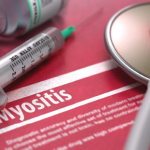 BALTIMORE—Many rheumatologists are aware of the 1975 Bohan and Peter criteria for the diagnosis of dermatomyositis and polymyositis, but fewer have been willing to reconsider these criteria in the era of recognized myositis-associated autoantibodies and their correlated phenotypes.1,2
BALTIMORE—Many rheumatologists are aware of the 1975 Bohan and Peter criteria for the diagnosis of dermatomyositis and polymyositis, but fewer have been willing to reconsider these criteria in the era of recognized myositis-associated autoantibodies and their correlated phenotypes.1,2
At the 20th Annual Advances in the Diagnosis and Treatment of the Rheumatic Diseases Symposium at Johns Hopkins School of Medicine, Lisa Christopher-Stine, MD, MPH, professor of medicine, director of the Myositis Center, Johns Hopkins School of Medicine, Baltimore, delved deeply into this topic with her presentation, Updates in Myositis.
Subtypes
To begin with, Dr. Christopher-Stine made a bold claim: Polymyositis does not truly exist. She explained that what was once conceptualized as polymyositis may actually be an overlap syndrome with features of several different conditions presenting in the same patient.
Subtypes of idiopathic inflammatory myopathies include juvenile dermatomyositis, amyopathic dermatomyositis, immune-mediated necrotizing myopathy and antisynthetase syndrome.3
The last of these subtypes—antisynthetase syndrome—requires the presence of an antibody directed against members of the tRNA synthetase family. The syndrome typically has three cardinal features: interstitial lung disease (ILD), myositis and arthritis. Other manifestations are common in antisynthetase syndrome, such as Raynaud’s phenomenon, mechanic’s hands and fever, but Dr. Christopher-Stine considers these supportive rather than essential findings. Patients with antisynthetase syndrome may or may not have skin involvement as part of their disease, and interesting cutaneous findings, such as hiker’s feet, have been described in the literature.4
Dr. Christopher-Stine noted that about 40% of patients with arthritis as part of the syndrome will present with a rheumatoid arthritis-like pattern. This finding—coupled with the fact that some culprit antibodies have yet to be discovered and may be labeled as unidentified on certain test panels—can make the condition challenging to diagnose.
Novel Antibodies
Dr. Christopher-Stine was excited to inform the audience of two novel anti-aminoacyl tRNA synthetase antibodies that have recently been described in Japan. Muro et al. took the sera of more than 300 patients with myositis—mostly dermatomyositis—and screened them against four tRNA synthetases: CysARS, ValARS, SerARS and TrpARS. Sera from two patients were found to react to CysARS and ValARS. More specifically, the patient with anti-CysARS antibodies had a phenotype that included myositis, Gottron’s papule/sign, ILD, mechanic’s hands, non-erosive arthritis, fever and Raynaud’s phenomenon. The patient with anti-ValARS antibodies had Gottron’s sign, heliotrope rash, and mechanic’s hands and was classified with amyopathic dermatomyositis; this patient also had antibodies to transcriptional intermediary factor 1 gamma (TIF1γ).5


